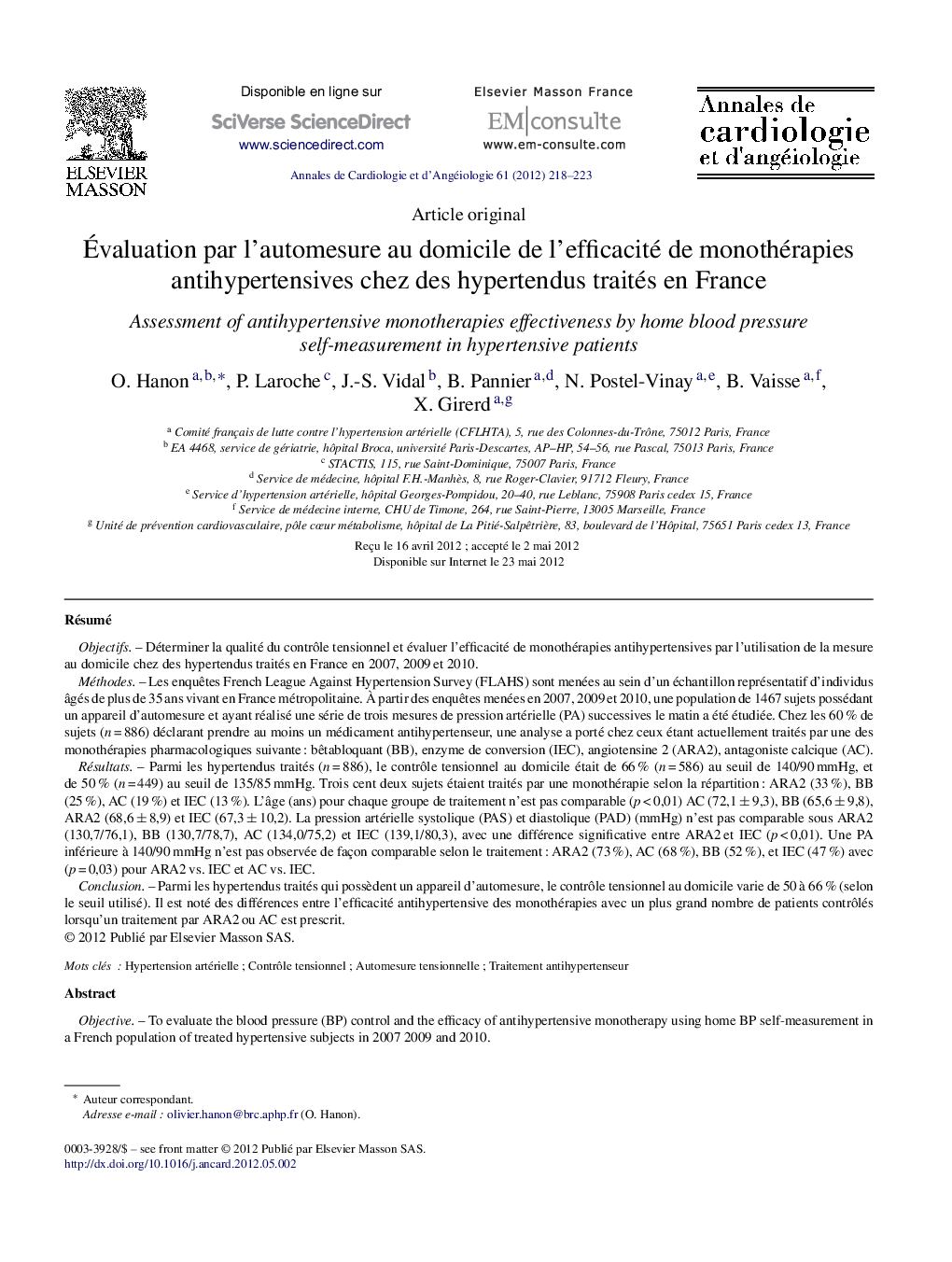| Article ID | Journal | Published Year | Pages | File Type |
|---|---|---|---|---|
| 2869115 | Annales de Cardiologie et d'Angéiologie | 2012 | 6 Pages |
RésuméObjectifsDéterminer la qualité du contrôle tensionnel et évaluer l’efficacité de monothérapies antihypertensives par l’utilisation de la mesure au domicile chez des hypertendus traités en France en 2007, 2009 et 2010.MéthodesLes enquêtes French League Against Hypertension Survey (FLAHS) sont menées au sein d’un échantillon représentatif d’individus âgés de plus de 35 ans vivant en France métropolitaine. À partir des enquêtes menées en 2007, 2009 et 2010, une population de 1467 sujets possédant un appareil d’automesure et ayant réalisé une série de trois mesures de pression artérielle (PA) successives le matin a été étudiée. Chez les 60 % de sujets (n = 886) déclarant prendre au moins un médicament antihypertenseur, une analyse a porté chez ceux étant actuellement traités par une des monothérapies pharmacologiques suivante : bêtabloquant (BB), enzyme de conversion (IEC), angiotensine 2 (ARA2), antagoniste calcique (AC).RésultatsParmi les hypertendus traités (n = 886), le contrôle tensionnel au domicile était de 66 % (n = 586) au seuil de 140/90 mmHg, et de 50 % (n = 449) au seuil de 135/85 mmHg. Trois cent deux sujets étaient traités par une monothérapie selon la répartition : ARA2 (33 %), BB (25 %), AC (19 %) et IEC (13 %). L’âge (ans) pour chaque groupe de traitement n’est pas comparable (p < 0,01) AC (72,1 ± 9,3), BB (65,6 ± 9,8), ARA2 (68,6 ± 8,9) et IEC (67,3 ± 10,2). La pression artérielle systolique (PAS) et diastolique (PAD) (mmHg) n’est pas comparable sous ARA2 (130,7/76,1), BB (130,7/78,7), AC (134,0/75,2) et IEC (139,1/80,3), avec une différence significative entre ARA2 et IEC (p < 0,01). Une PA inférieure à 140/90 mmHg n’est pas observée de façon comparable selon le traitement : ARA2 (73 %), AC (68 %), BB (52 %), et IEC (47 %) avec (p = 0,03) pour ARA2 vs. IEC et AC vs. IEC.ConclusionParmi les hypertendus traités qui possèdent un appareil d’automesure, le contrôle tensionnel au domicile varie de 50 à 66 % (selon le seuil utilisé). Il est noté des différences entre l’efficacité antihypertensive des monothérapies avec un plus grand nombre de patients contrôlés lorsqu’un traitement par ARA2 ou AC est prescrit.
ObjectiveTo evaluate the blood pressure (BP) control and the efficacy of antihypertensive monotherapy using home BP self-measurement in a French population of treated hypertensive subjects in 2007 2009 and 2010.MethodsThe French League Against Hypertension Surveys (FLAHS) are conducted among a representative sample of individuals aged 35 years and older living in France. For the 2007, 2009 and 2010 surveys, a sample of 1467 subjects who owned a BP self-measurement device and performed three consecutive morning BP measurements were included. Among the 60% of subjects who reported taking at least one antihypertensive drug, we analyzed subjects treated with one of the following antihypertensive monotherapy, i.e., beta-blocker (BB), ACE inhibitors, calcium channel blocker (CCB) and angiotensin receptor blockers (ARB).ResultsAmong treated hypertensive subjects (n = 886), 66% (n = 586) had home BP below the 140/90 mmHg threshold and 50% (n = 449) below 135/85 mmHg. Three hundred two subjects were treated with a single antihypertensive drug, 33% had ARB, 25% BB, 19% CCB and 13% ACE inhibitors. Age (years) for each treatment group is different (P < 0.01) CCB (72.1 ± 9.3), BB (65.6 ± 9.8), ARB (68.6 ± 8.9) and ACEI (67.3 ± 10.2). The mean systolic/diastolic BP (mmHg) is not comparable between monotherapy 130.7/76.1 (ARB), 130.7/78.7 (BB), 134.0/75.2 (CCB) and 139.1/80.3 (ACEI) for ARB, BB, CCB and ACE inhibitors respectively. Compared to ACE inhibitors, BP was significantly lower with ARB (P < 0.01). The proportion of subjects with a BP below 140/90 mmHg was 73% for ARB, 52% for BB, 68% for CCB and 47% for ACE with a statistical significance (P = 0.03) for ARB vs. ACEI and CCB vs. ACEI.ConclusionAmong subjects treated for hypertension who owned a BP self-measurement device, 50 to 66% had a controlled BP (depending on the threshold used). It is observed differences between antihypertensive efficacy of monotherapy with a larger number of patients controlled with ARB or CCB.
